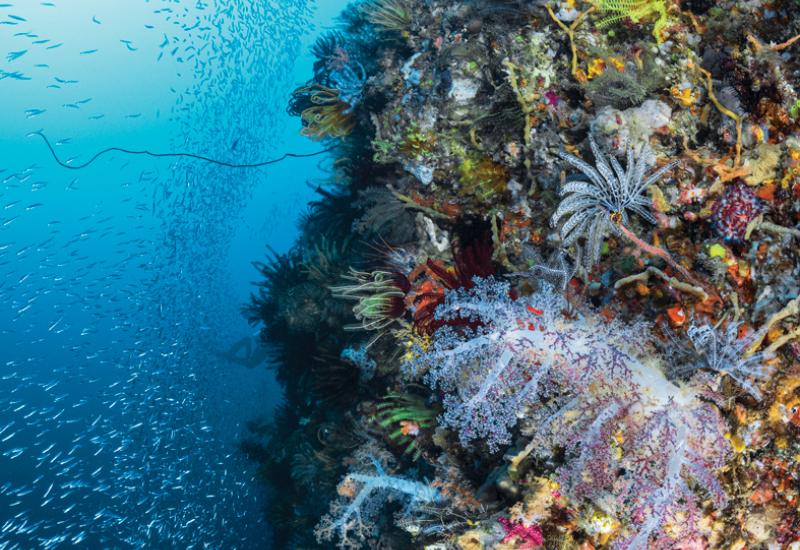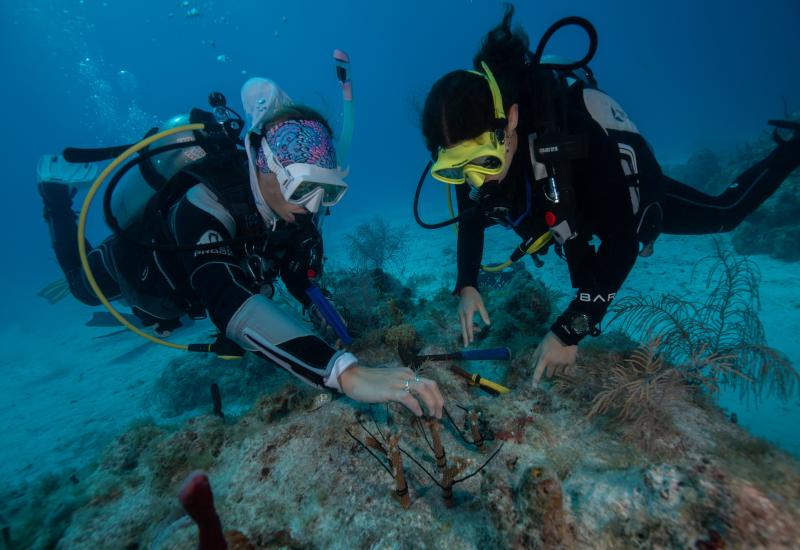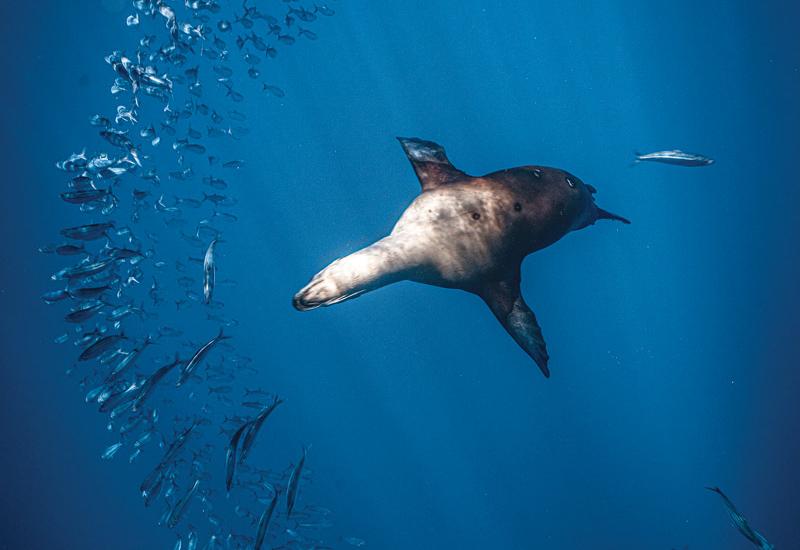The Florida Keys & Key West
Famed around the globe, the clear, warm waters of the Florida Keys, surrounded by North America's only living coral barrier reef, attract almost 800,000 scuba and snorkel aficionados annually, and there is no better destination to learn how to get "up close and personal" with the undersea environment.
 The Keys' combination of vivid coral reefs teeming with exotic sea creatures and a wealth of first-rate snorkel/dive operators offers a ready-made vacation paradise for those who can't wait to get into the water and start exploring.
The Keys' combination of vivid coral reefs teeming with exotic sea creatures and a wealth of first-rate snorkel/dive operators offers a ready-made vacation paradise for those who can't wait to get into the water and start exploring.
To maintain the Keys' status as the world's most popular dive destination, the region's offshore environment has been the focus of conservation efforts for more than a generation.
The Florida Keys National Marine Sanctuary, established in 1990, encompasses the coastal waters of the entire island chain from northernmost Key Largo south to the Dry Tortugas. Keys conservation efforts got under way in 1960 when widespread public support laid the foundation for John Pennekamp Coral Reef State Park off Key Largo, named for a late Miami newspaper editor who championed local environmental preservation.
 The undersea park features the nine-foot-high "Christ of the Deep," a 4,000-pound bronze statue installed as an underwater shrine. Created by Italian sculptor Guido Galletti, the statue stands on a 20-ton concrete base in 25 feet of water. A duplicate of the "Christ of the Abyss" situated in 50 feet of water off the coast of Italy, the "Christ of the Deep" was a gift to the Underwater Society of America from industrialist and undersea sportsman Egidi Cressi. It has become one of the most photographed underwater sites in the world and is a popular spot for underwater weddings.
The undersea park features the nine-foot-high "Christ of the Deep," a 4,000-pound bronze statue installed as an underwater shrine. Created by Italian sculptor Guido Galletti, the statue stands on a 20-ton concrete base in 25 feet of water. A duplicate of the "Christ of the Abyss" situated in 50 feet of water off the coast of Italy, the "Christ of the Deep" was a gift to the Underwater Society of America from industrialist and undersea sportsman Egidi Cressi. It has become one of the most photographed underwater sites in the world and is a popular spot for underwater weddings.
The 510-foot Spiegel Grove, a retired U.S. Navy Landing Ship Dock, is the largest ship ever intentionally sunk to create an artificial reef. The vessel was the center of international attention when it prematurely sank and rolled over May 17, 2002. Three weeks later, a salvage team successfully reoriented the ship on its right side and it subsequently opened to divers. Then in July 2005, mother nature, by way of Hurricane Dennis, righted the ship to its sought upright position. An excellent multilevel dive, the huge ship attracts legions of fish and other marine life. The ship can be viewed by scuba divers, snorkelers and even glass-bottom boat patrons. The Spiegel Grove is positioned about six miles off Key Largo in 130 feet of water. Several mooring buoys provide convenient tie-off points for boaters.
Experienced scuba divers also can investigate two vintage sister Coast Guard cutters purposely sunk off Key Largo in 1987 to serve as artificial reefs. Positioned just south of Molasses Reef, the 327-foot vessels rest on white sand in 120 feet of water. Diving either of the two wrecks is not for novices and should be attempted only with a Keys-based dive-charter operator.
 To the west of Looe Key in the Lower Keys lies the 210-foot freighter Adolphus Busch Senior. Since Dec. 5, 1998, divers have been exploring this artificial reef approximately five miles southwest of Big Pine Key.
To the west of Looe Key in the Lower Keys lies the 210-foot freighter Adolphus Busch Senior. Since Dec. 5, 1998, divers have been exploring this artificial reef approximately five miles southwest of Big Pine Key.
A sunken Spanish galleon of 1733 is the focus of the San Pedro Underwater Archaeological Preserve off Islamorada. Little remains of the underwater wreck after 250 years, but it continues to be a favorite of snorkelers and divers, and curators of the site have added authentic touches, including seven concrete cannon replicas and an 18th-century ship's anchor.
In fact, the waters surrounding the Keys are home to so many unique shipwrecks that the Florida Keys National Marine Sanctuary has created the Florida Keys Shipwreck Heritage Trail. This water-based line of nine notable wrecksites stretches from Key Largo to Key West and is suitable for snorkeling and diving. The trail was created to encourage an appreciation and understanding of the Florida Keys' maritime heritage.
Resting in depths from 20 to 130 feet, the wrecks on the shipwreck trail reflect a diversity of origins and locations. There are vessels of Spanish explorers dating to the early 1700s, as well as modern cargo and military ships.
 The collection includes such highlights as the La Capitana wreck, from Spain's 1733 Armada, discovered in the late 1930s by salvor Art McKee, who later uncovered the sites of the Infante, Herrera, Chaves, San Pedro and the San Joseph.
The collection includes such highlights as the La Capitana wreck, from Spain's 1733 Armada, discovered in the late 1930s by salvor Art McKee, who later uncovered the sites of the Infante, Herrera, Chaves, San Pedro and the San Joseph.
Salvor Mel Fisher followed in McKee's footsteps, uncovering the shipwrecked Spanish galleon Nuestra Señora de Atocha in waters off Key West. Fisher and his team also recovered artifacts from the Atocha's sister ship, the Santa Margarita, and the English merchant slave vessel Henrietta Marie, discovered near the Marquesas Keys.
Vessels including a merchant marine freighter, a cargo transporter, a three-masted bark and a former destroyer are among the others featured along the shipwreck trail.
Whether diving or snorkeling to catch a glimpse of the extraordinary creatures that inhabit the Keys' coral reef ecosystem or to re-discover vessels that sank centuries ago, those with a passion for the underwater world can feed that passion in the waters off the Florida Keys.
www.fla-keys.com/diving | 800-FLA-KEYS
(Photography by Stephen Frink_)_
Famed around the globe, the clear, warm waters of the Florida Keys, surrounded by North America's only living coral barrier reef, attract almost 800,000 scuba and snorkel aficionados annually, and there is no better destination to learn how to get "up close and personal" with the undersea environment.
 The Keys' combination of vivid coral reefs teeming with exotic sea creatures and a wealth of first-rate snorkel/dive operators offers a ready-made vacation paradise for those who can't wait to get into the water and start exploring.
The Keys' combination of vivid coral reefs teeming with exotic sea creatures and a wealth of first-rate snorkel/dive operators offers a ready-made vacation paradise for those who can't wait to get into the water and start exploring.
To maintain the Keys' status as the world's most popular dive destination, the region's offshore environment has been the focus of conservation efforts for more than a generation.
The Florida Keys National Marine Sanctuary, established in 1990, encompasses the coastal waters of the entire island chain from northernmost Key Largo south to the Dry Tortugas. Keys conservation efforts got under way in 1960 when widespread public support laid the foundation for John Pennekamp Coral Reef State Park off Key Largo, named for a late Miami newspaper editor who championed local environmental preservation.
 The undersea park features the nine-foot-high "Christ of the Deep," a 4,000-pound bronze statue installed as an underwater shrine. Created by Italian sculptor Guido Galletti, the statue stands on a 20-ton concrete base in 25 feet of water. A duplicate of the "Christ of the Abyss" situated in 50 feet of water off the coast of Italy, the "Christ of the Deep" was a gift to the Underwater Society of America from industrialist and undersea sportsman Egidi Cressi. It has become one of the most photographed underwater sites in the world and is a popular spot for underwater weddings.
The undersea park features the nine-foot-high "Christ of the Deep," a 4,000-pound bronze statue installed as an underwater shrine. Created by Italian sculptor Guido Galletti, the statue stands on a 20-ton concrete base in 25 feet of water. A duplicate of the "Christ of the Abyss" situated in 50 feet of water off the coast of Italy, the "Christ of the Deep" was a gift to the Underwater Society of America from industrialist and undersea sportsman Egidi Cressi. It has become one of the most photographed underwater sites in the world and is a popular spot for underwater weddings.
The 510-foot Spiegel Grove, a retired U.S. Navy Landing Ship Dock, is the largest ship ever intentionally sunk to create an artificial reef. The vessel was the center of international attention when it prematurely sank and rolled over May 17, 2002. Three weeks later, a salvage team successfully reoriented the ship on its right side and it subsequently opened to divers. Then in July 2005, mother nature, by way of Hurricane Dennis, righted the ship to its sought upright position. An excellent multilevel dive, the huge ship attracts legions of fish and other marine life. The ship can be viewed by scuba divers, snorkelers and even glass-bottom boat patrons. The Spiegel Grove is positioned about six miles off Key Largo in 130 feet of water. Several mooring buoys provide convenient tie-off points for boaters.
Experienced scuba divers also can investigate two vintage sister Coast Guard cutters purposely sunk off Key Largo in 1987 to serve as artificial reefs. Positioned just south of Molasses Reef, the 327-foot vessels rest on white sand in 120 feet of water. Diving either of the two wrecks is not for novices and should be attempted only with a Keys-based dive-charter operator.
 To the west of Looe Key in the Lower Keys lies the 210-foot freighter Adolphus Busch Senior. Since Dec. 5, 1998, divers have been exploring this artificial reef approximately five miles southwest of Big Pine Key.
To the west of Looe Key in the Lower Keys lies the 210-foot freighter Adolphus Busch Senior. Since Dec. 5, 1998, divers have been exploring this artificial reef approximately five miles southwest of Big Pine Key.
A sunken Spanish galleon of 1733 is the focus of the San Pedro Underwater Archaeological Preserve off Islamorada. Little remains of the underwater wreck after 250 years, but it continues to be a favorite of snorkelers and divers, and curators of the site have added authentic touches, including seven concrete cannon replicas and an 18th-century ship's anchor.
In fact, the waters surrounding the Keys are home to so many unique shipwrecks that the Florida Keys National Marine Sanctuary has created the Florida Keys Shipwreck Heritage Trail. This water-based line of nine notable wrecksites stretches from Key Largo to Key West and is suitable for snorkeling and diving. The trail was created to encourage an appreciation and understanding of the Florida Keys' maritime heritage.
Resting in depths from 20 to 130 feet, the wrecks on the shipwreck trail reflect a diversity of origins and locations. There are vessels of Spanish explorers dating to the early 1700s, as well as modern cargo and military ships.
 The collection includes such highlights as the La Capitana wreck, from Spain's 1733 Armada, discovered in the late 1930s by salvor Art McKee, who later uncovered the sites of the Infante, Herrera, Chaves, San Pedro and the San Joseph.
The collection includes such highlights as the La Capitana wreck, from Spain's 1733 Armada, discovered in the late 1930s by salvor Art McKee, who later uncovered the sites of the Infante, Herrera, Chaves, San Pedro and the San Joseph.
Salvor Mel Fisher followed in McKee's footsteps, uncovering the shipwrecked Spanish galleon Nuestra Señora de Atocha in waters off Key West. Fisher and his team also recovered artifacts from the Atocha's sister ship, the Santa Margarita, and the English merchant slave vessel Henrietta Marie, discovered near the Marquesas Keys.
Vessels including a merchant marine freighter, a cargo transporter, a three-masted bark and a former destroyer are among the others featured along the shipwreck trail.
Whether diving or snorkeling to catch a glimpse of the extraordinary creatures that inhabit the Keys' coral reef ecosystem or to re-discover vessels that sank centuries ago, those with a passion for the underwater world can feed that passion in the waters off the Florida Keys.
www.fla-keys.com/diving | 800-FLA-KEYS
(Photography by Stephen Frink_)_











